Honda Power Equipment EM4000SX, EM5000SX, EM6500SX user guide
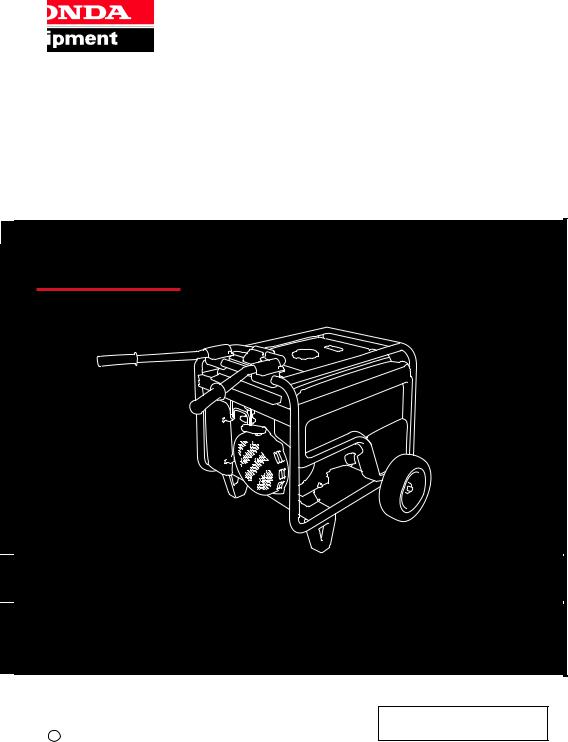
Owner’s Manual
GENERATOR |
EM4000SX/EM5000SX/EM6500SX |
Click to Save As |
See page 81 for instructions
C 2015 Honda Motor Co., Ltd. -All Rights Reserved on assembling your generator.

The engine exhaust from this product contains chemicals known to the State of California to cause cancer, birth defects or other reproductive harm.
California Proposition 65
This product contains or emits chemicals known to the state of California to cause cancer, birth defects or other reproductive harm
Exhaust contains poisonous carbon monoxide gas that can build up to dangerous levels in closed areas.
Breathing carbon monoxide can cause unconsciousness or death.
Never run the generator in a closed, or even partly closed area where people may be present.
Keep this owner’s manual handy so that you can refer to it at any time. This owner’s manual is considered a permanent part of the generator and should remain with the generator if resold.
The information and specifications included in this publication were in effect at the time of approval for printing. Honda Motor Co., Ltd. reserves the right, however, to discontinue or change specifications or design at any time without notice and without incurring any obligation whatsoever.

INTRODUCTION
Congratulations on your selection of a Honda generator. We are certain you will be pleased with your purchase of one of the finest generators on the market.
We want to help you get the best results from your new generator and to operate it safely. This manual contains all the information on how to do that; please read it carefully.
As you read this manual, you will find information preceded by a 



 symbol. That information is intended to help you avoid
symbol. That information is intended to help you avoid
damage to your generator, other property, or the environment.
We suggest you read the Distributor’s Limited Warranty to fully understand its coverage and your responsibilities of ownership. The Distributor’s Limited Warranty is a separate document that should have been given to you by your dealer.
When your generator needs scheduled maintenance, keep in mind that your Honda servicing dealer is specially trained in servicing Honda generators and is supported by the parts and service divisions of American Honda. Your Honda servicing dealer is dedicated to your satisfaction and will be pleased to answer your questions and concerns.
Best Wishes,
Honda Motor Co., Ltd.
1
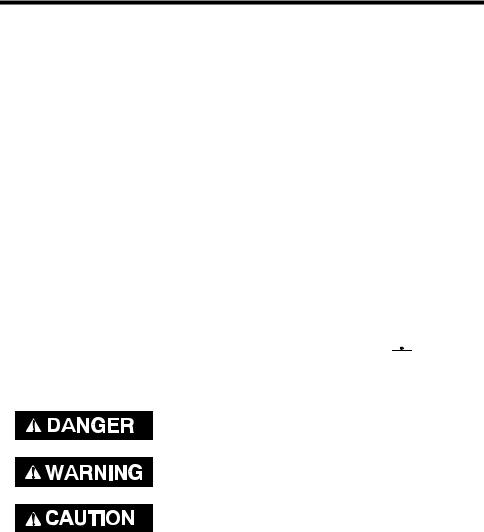
A FEW WORDS ABOUT SAFETY
Your safety and the safety of others are very important. And using this generator safely is an important responsibility.
To help you make informed decisions about safety, we have provided operating procedures and other information on labels and in this manual. This information alerts you to potential hazards that could hurt you or others.
Of course, it is not practical or possible to warn you about all the hazards associated with operating or maintaining a generator. You must use your own good judgment.
You will find important safety information in a variety of forms, including:
•Safety Labels — on the generator.
•Safety Messages — preceded by a safety alert symbol  and one of three signal words, DANGER, WARNING, or CAUTION.
and one of three signal words, DANGER, WARNING, or CAUTION.
These signal words mean:
You WILL be KILLED or SERIOUSLY HURT if you don’t follow instructions.
You CAN be KILLED or SERIOUSLY HURT if you don’t follow instructions.
You CAN be HURT if you don’t follow instructions.
•Safety Headings — such as IMPORTANT SAFETY INFORMATION.
•Safety Section — such as GENERATOR SAFETY.
•Instructions — how to use this generator correctly and safely.
This entire book is filled with important safety information — please read it carefully.
2
CONTENTS |
|
GENERATOR SAFETY ............................................................................... |
6 |
IMPORTANT SAFETY INFORMATION ................................................. |
6 |
Operator Responsibility..................................................................... |
6 |
Carbon Monoxide Hazards................................................................ |
6 |
Electric Shock Hazards ...................................................................... |
7 |
Fire and Burn Hazards ....................................................................... |
7 |
Refuel With Care ................................................................................ |
8 |
SAFETY LABEL LOCATIONS................................................................. |
9 |
CONTROLS & FEATURES....................................................................... |
10 |
COMPONENT & CONTROL LOCATIONS........................................... |
10 |
CONTROLS........................................................................................... |
12 |
Engine Switch .................................................................................. |
12 |
Starter Grip....................................................................................... |
12 |
Fuel Valve Lever............................................................................... |
13 |
Voltage Selector Switch .................................................................. |
13 |
Auto Throttle System ...................................................................... |
14 |
AC Circuit Breaker............................................................................ |
14 |
AC Circuit Protectors ....................................................................... |
15 |
Ground Fault Circuit Interrupter (GFCI) Receptacle ...................... |
16 |
DC Terminals.................................................................................... |
17 |
DC Circuit Protector ......................................................................... |
17 |
Folding Handle ................................................................................. |
18 |
FEATURES............................................................................................ |
19 |
Oil Alert System ............................................................................... |
19 |
Automatic Engine Stop Function.................................................... |
19 |
Oil Alert Function ............................................................................. |
19 |
Overspeed Detection Function ....................................................... |
19 |
Abnormal Voltage Detection Function........................................... |
19 |
Auto Choke and Throttle Control System...................................... |
20 |
iAVR (Intelligent Auto Voltage Regulator) ..................................... |
20 |
Fuel Gauge ....................................................................................... |
21 |
Ground Terminal.............................................................................. |
21 |
BEFORE OPERATION .............................................................................. |
22 |
ARE YOU READY TO GET STARTED?................................................ |
22 |
Knowledge........................................................................................ |
22 |
IS YOUR GENERATOR READY TO GO?............................................. |
22 |
Check the Engine ............................................................................. |
23 |
Check the GFCI ................................................................................. |
23 |
3

CONTENTS |
|
OPERATION ............................................................................................. |
24 |
SAFE OPERATING PRECAUTIONS..................................................... |
24 |
STARTING THE ENGINE ..................................................................... |
25 |
STOPPING THE ENGINE ..................................................................... |
28 |
GFCI OPERATION CHECK ................................................................... |
29 |
AC OPERATION.................................................................................... |
31 |
AC Applications................................................................................ |
33 |
AC Receptacle Selection.................................................................. |
34 |
Power Producing Circuits................................................................ |
34 |
Voltage Selector Switch .................................................................. |
35 |
DC OPERATION.................................................................................... |
37 |
AUTO THROTTLE SYSTEM................................................................. |
39 |
STANDBY POWER ............................................................................... |
40 |
Connections to a Building’s Electrical System .............................. |
40 |
System Ground ................................................................................ |
40 |
Special Requirements...................................................................... |
41 |
SERVICING YOUR GENERATOR............................................................ |
42 |
THE IMPORTANCE OF MAINTENANCE............................................. |
42 |
MAINTENANCE SAFETY..................................................................... |
43 |
Safety Precautions ........................................................................... |
43 |
MAINTENANCE SCHEDULE ............................................................... |
44 |
REFUELING .......................................................................................... |
45 |
FUEL RECOMMENDATIONS............................................................... |
46 |
ENGINE OIL LEVEL CHECK ................................................................. |
47 |
ENGINE OIL CHANGE.......................................................................... |
48 |
ENGINE OIL RECOMMENDATIONS ................................................... |
49 |
AIR CLEANER SERVICE ....................................................................... |
50 |
AIR CLEANER ELEMENT CLEANING ................................................. |
52 |
SPARK PLUG SERVICE........................................................................ |
53 |
SPARK ARRESTER SERVICE............................................................... |
55 |
SEDIMENT CUP CLEANING................................................................ |
56 |
BATTERY SERVICE .............................................................................. |
57 |
FUSE ..................................................................................................... |
61 |
STORAGE................................................................................................. |
62 |
STORAGE PREPARATION................................................................... |
62 |
Cleaning............................................................................................ |
62 |
Fuel.................................................................................................... |
62 |
Engine Oil ......................................................................................... |
65 |
Engine Cylinder................................................................................ |
65 |
STORAGE PRECAUTIONS .................................................................. |
66 |
REMOVAL FROM STORAGE............................................................... |
66 |
4

|
|
CONTENTS |
TRANSPORTING...................................................................................... |
|
67 |
TAKING CARE OF UNEXPECTED PROBLEMS ...................................... |
|
68 |
ENGINE WILL NOT START.................................................................. |
|
68 |
ENGINE LACKS POWER...................................................................... |
|
69 |
NO POWER AT THE AC RECEPTACLES............................................. |
|
70 |
NO POWER AT THE DC TERMINALS ................................................. |
|
70 |
TECHNICAL INFORMATION ................................................................... |
|
71 |
Serial Number Location ...................................................................... |
|
71 |
Carburetor Modification for High Altitude Operation |
.......................72 |
|
Emission Control System Information............................................... |
|
73 |
Air Index ............................................................................................... |
|
75 |
Specifications....................................................................................... |
|
76 |
Wiring Diagram.................................................................................... |
|
77 |
CONSUMER INFORMATION .................................................................. |
|
79 |
Dealer Locator Information................................................................. |
|
79 |
Honda Publications.............................................................................. |
|
79 |
Customer Service Information ........................................................... |
|
80 |
ASSEMBLY .............................................................................................. |
|
81 |
SAFETY................................................................................................. |
|
81 |
The Importance of Proper Assembly ............................................. |
|
81 |
Important Safety Precautions ......................................................... |
|
82 |
ASSEMBLY........................................................................................... |
|
83 |
Unpacking......................................................................................... |
|
83 |
Loose Parts ....................................................................................... |
|
83 |
Wheel Kit Installation....................................................................... |
|
84 |
Handle Installation ........................................................................... |
|
85 |
INITIAL USE INSTRUCTIONS ................................................................. |
|
86 |
ENGINE OIL.......................................................................................... |
|
86 |
FUEL...................................................................................................... |
|
87 |
BATTERY .............................................................................................. |
|
88 |
BEFORE OPERATION........................................................................... |
|
89 |
REGISTRATION.................................................................................... |
|
89 |
OPTIONAL PARTS ................................................................................... |
|
90 |
Remote Control Kit .............................................................................. |
|
90 |
Remote Control Box ............................................................................ |
|
91 |
Hanger Kit............................................................................................. |
|
92 |
INDEX ....................................................................................................... |
|
93 |
QUICK REFERENCE INFORMATION ............................ |
Inside back cover |
|
5
GENERATOR SAFETY
IMPORTANT SAFETY INFORMATION
Honda generators are designed for use with electrical equipment that has suitable power requirements. Other uses can result in injury to the operator or damage to the generator and other property.
Most injuries or property damage can be prevented if you follow all instructions in this manual and on the generator. The most common hazards are discussed below, along with the best way to protect yourself and others.
Operator Responsibility
•Know how to stop the generator quickly in case of emergency.
•Understand the use of all generator controls, output receptacles, and connections.
•Be sure that anyone who operates the generator receives proper instruction. Do not let children operate the generator without parental supervision.
Carbon Monoxide Hazards
A generator's exhaust contains toxic carbon monoxide, which you cannot see or smell. Breathing carbon monoxide can KILL YOU IN MINUTES. To avoid carbon monoxide poisoning, follow these instructions when operating a generator:
•Only run a generator OUTSIDE, far away from windows, doors, and vents.
•Never operate a generator inside a house, garage, basement, crawl space, or any enclosed or partially enclosed space.
•Never operate a generator near open doors or windows.
•Get fresh air and seek medical attention immediately if you suspect you have inhaled carbon monoxide.
Early symptoms of carbon monoxide exposure include headache, fatigue, shortness of breath, nausea, and dizziness. Continued exposure to carbon monoxide can cause loss of muscular coordination, loss of consciousness, and then death.
To alert you to potentially dangerous levels of carbon monoxide coming from a generator operating outside, or from other sources, install battery operated carbon monoxide alarms or plug-in carbon monoxide alarms with battery back-up on every level of the home and outside sleeping areas in accordance with the manufacturer's instructions.
6

GENERATOR SAFETY
Electric Shock Hazards
•The generator produces enough electric power to cause a serious shock or electrocution if misused.
•Using a generator or electrical appliance in wet conditions, such as rain or snow, or near a pool or sprinkler system, or when your hands are wet, could result in electrocution. Keep the generator dry.
•If the generator is stored outdoors, unprotected from the weather, check the Ground Fault Circuit Interrupter (GFCI) receptacle and all other electrical components on the control panel before each use.
Moisture or ice can cause a malfunction or short circuit in electrical components that could result in electrocution.
•Do not connect to a building’s electrical system unless an isolation switch has been installed by a qualified electrician.
Fire and Burn Hazards
•The exhaust system gets hot enough to ignite some materials.
–Keep the generator at least 3 feet (1 meter) away from buildings and other equipment during operation.
–Do not enclose the generator in any structure.
–Keep flammable materials away from the generator.
•The muffler becomes very hot during operation and remains hot for a while after stopping the engine. Be careful not to touch the muffler while it is hot. Let the engine cool before storing the generator indoors.
7

GENERATOR SAFETY
Refuel With Care
Gasoline is extremely flammable, and gasoline vapor can explode. Do not refuel during operation.
Allow the engine to cool if it has been in operation.
Refuel only outdoors in a well-ventilated area and on a level surface. Never smoke near gasoline, and keep other flames and sparks away. Do not overfill the fuel tank.
Make sure that any spilled fuel has been wiped up before starting the engine.
Always store gasoline in an approved container.
8
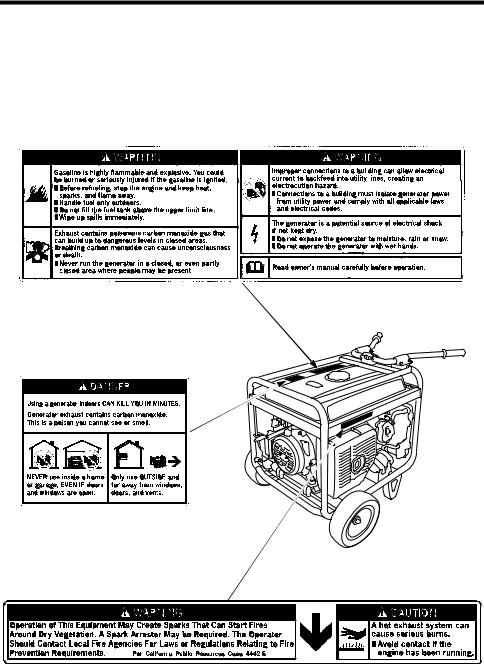
GENERATOR SAFETY
SAFETY LABEL LOCATIONS
These labels warn you of potential hazards that can cause serious injury. Read them carefully.
If a label comes off or becomes hard to read, contact your Honda generator dealer for a replacement.
9
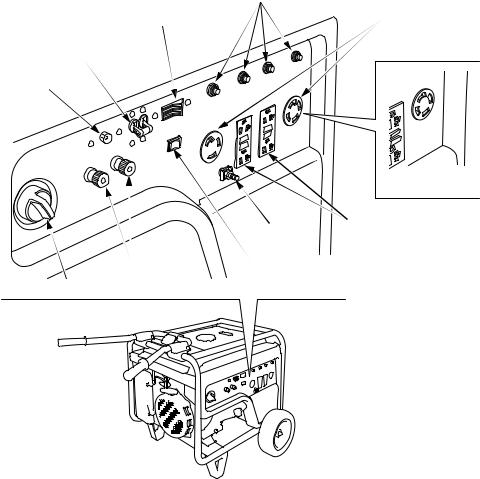
CONTROLS & FEATURES
COMPONENT & CONTROL LOCATIONS
Use the illustrations on these pages to locate and identify the most frequently used controls.
AC CIRCUIT PROTECTORS |
|
VOLTAGE SELECTOR SWITCH |
RECEPTACLES |
|
AC CIRCUIT BREAKER
DC CIRCUIT
PROTECTOR
*
<EM4000SX>
GFCI RECEPTACLES
GROUND
TERMINAL
DC TERMINALS |
AUTO THROTTLE SWITCH |
ENGINE SWITCH
*: Except EM4000SX
10
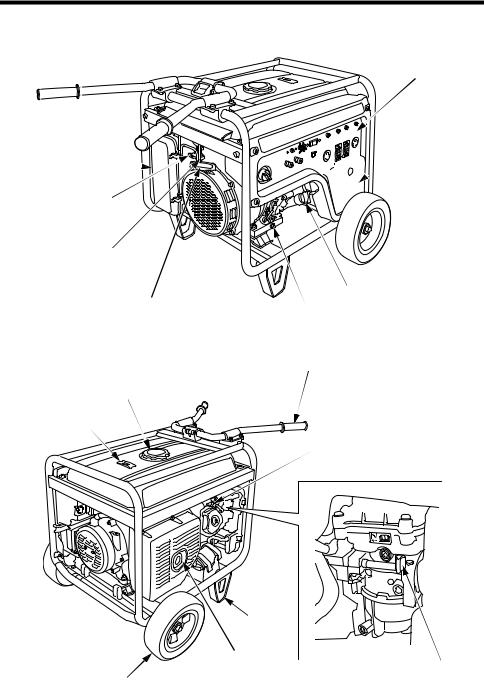
CONTROLS & FEATURES
AIR CLEANER 
FUEL VALVE LEVER
SEDIMENT CUP
STARTER GRIP
FUEL TANK CAP
FUEL GAUGE
WHEEL
CONTROL PANEL

 BATTERY COVER
BATTERY COVER
OIL FILLER CAP/DIPSTICK
OIL DRAIN PLUG
HANDLE
SPARK PLUG
STAND
MUFFLER
MANUAL CHOKE LEVER
11
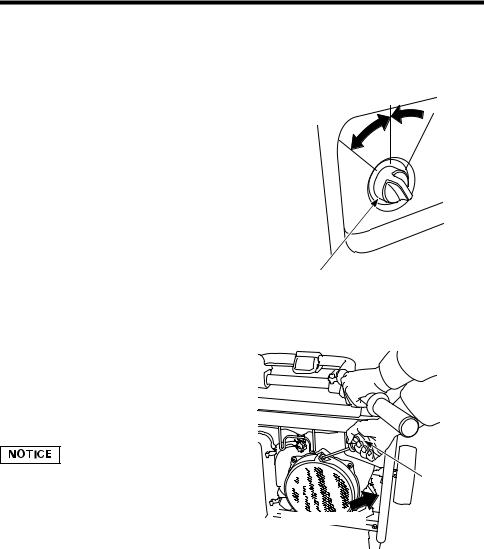
CONTROLS & FEATURES
CONTROLS
Engine Switch
The engine switch controls the ignition system, and it operates the electric starter.
OFF – Stops the engine. The engine switch key can be removed/inserted.
ON – Running position, and for starting with the recoil starter.
START – Operates the electric starter.
Starter Grip
Used when the battery voltage is too low to turn the starter motor. Pulling the starter grip operates the recoil starter to crank the engine.
•Do not allow the starter grip to snap back against the generator. Return it gently to prevent damage to the starter.
•Do not let the starter rope rub against the generator body, or the rope will wear out prematurely.
•Be careful not to hit your hand against the handle when pulling the starter grip.
ON
 START
START
OFF
ENGINE SWITCH
STARTER
GRIP
 Direction
Direction
 to pull
to pull
12

CONTROLS & FEATURES
Fuel Valve Lever
The fuel valve lever is located between the fuel tank and carburetor.
The fuel valve must be in the ON position for the engine to run.
After stopping the engine, turn the fuel valve to the OFF position.
Voltage Selector Switch
ON




 OFF
OFF
FUEL VALVE LEVER
The voltage selector switch switches generator output to produce ‘‘120V ONLY’’ or ‘‘120V/240V.’’ If a 240V appliance is connected to the 4-prong receptacle, the switch must be in the ‘‘120V/240V’’ position. If only a 120V appliance is being connected to any of the 120V 3-prong receptacles, select the ‘‘120V ONLY’’ position.
Select the voltage before starting the engine.
Switch Position
120V/240V: The 120V and 120V/240V receptacles can be used simultaneously.
120V ONLY: ONLY 120 volts is available in this position; 240 volts is not available. The most power will be available at the 30A 120V locking plug receptacle.
VOLTAGE SELECTOR SWITCH
120 V/240 V
120 V ONLY
13
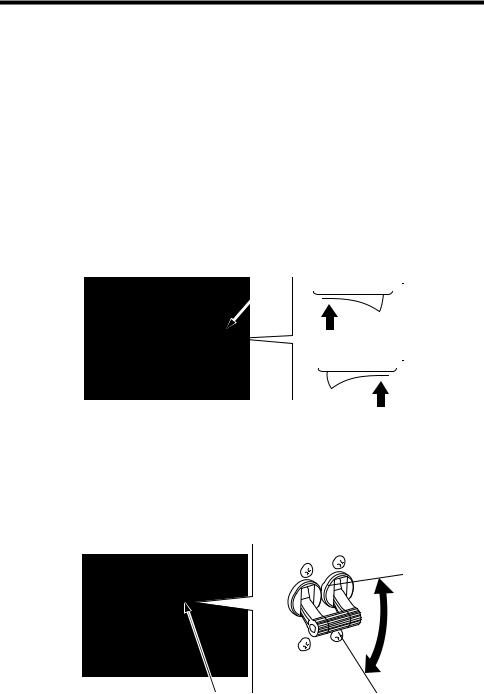
CONTROLS & FEATURES
Auto Throttle® System
The Auto Throttle® system automatically reduces engine speed when all loads are turned off or disconnected. When appliances are turned on or reconnected, the engine returns to the rated speed.
Switch Position
AUTO: Recommended to minimize fuel consumption and further reduce noise levels when no load is applied to the generator.
OFF: The Auto Throttle system does not operate.
Recommended to minimize warm-up time when the generator is started and when starting a load with large start-up power requirements.
AUTO THROTTLE SWITCH
OFF




 ON
ON
OFF
ON
AC Circuit Breaker
The AC circuit breaker will automatically switch OFF if there is a short circuit or a significant overload at the receptacles.
The AC circuit breaker may be used to switch the generator power ON or OFF.
ON
AC CIRCUIT BREAKER |
OFF |
14
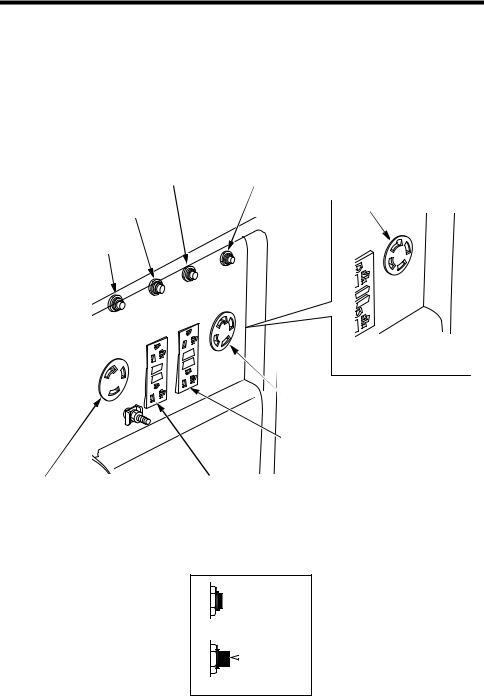
CONTROLS & FEATURES
AC Circuit Protectors
The AC circuit protectors will automatically switch OFF if there is a short circuit or a significant overload of the generator at each receptacle. If an AC circuit protector switches OFF automatically, check that the appliance is working properly and does not exceed the rated load capacity of the circuit before resetting the AC circuit protector ON.
AC CIRCUIT PROTECTOR |
AC CIRCUIT PROTECTOR for Receptacle |
for Receptacle |
|
AC CIRCUIT PROTECTOR |
120/240 V 20 A |
|
|
for Receptacle |
|
AC CIRCUIT PROTECTOR |
|
for Receptacle |
|
* |
|
|
<EM4000SX> |
|
120/240 V 30 A |
|
GFCI RECEPTACLE |
|
(120 V 20 A DUPLEX RECEPTACLE) |
120 V 30 A |
GFCI RECEPTACLE |
|
(120 V 20 A DUPLEX RECEPTACLE) |
*: Except EM4000SX |
|
|
AC CIRCUIT PROTECTOR |
ON
 PUSH
PUSH
OFF
15

CONTROLS & FEATURES
Ground Fault Circuit Interrupter (GFCI) Receptacle
Each 120 V 20 A duplex receptacle is protected by a Ground Fault Circuit Interrupter (GFCI) for protection against the shock hazard of ground-fault currents.
An example of ground-fault current is the current that would flow through a person who is using an appliance with faulty insulation and, at the same time, is in contact with an electrical ground such as a plumbing fixture, wet floor, or earth. The GFCI will protect against current flowing through that person.
The GFCI will not protect against short circuit or overloads.
GFCIs can be expected to interrupt power supply if there are ground faults or stray current imposed on the wiring by other electrical devices, wiring, or equipment. Due to the risk of a power interruption, this generator is not recommended for powering medical or life support equipment.
GFCI TEST BUTTON
GFCI RESET BUTTON
GFCI RECEPTACLES
(120 V 20 A DUPLEX RECEPTACLES)
16
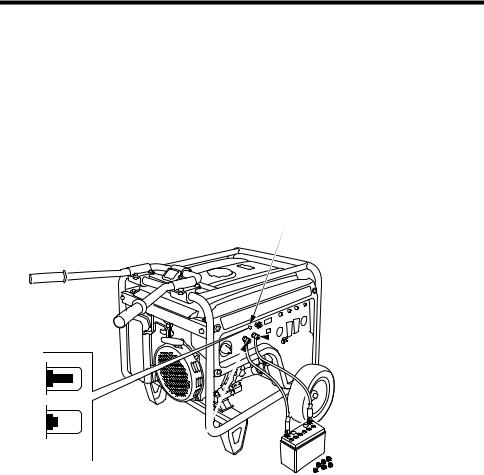
CONTROLS & FEATURES
DC Terminals
The DC terminals may ONLY be used for charging 12-volt automotive type batteries.
The terminals are colored red to identify the positive (+) terminal and black to identify the negative (–) terminal. The battery must be connected to the generator DC terminals with the proper polarity (battery positive to generator red terminal and battery negative to the generator black terminal).
DC CIRCUIT PROTECTOR
 POSITIVE DC TERMINAL (RED)
POSITIVE DC TERMINAL (RED)
OFF
ON
NEGATIVE DC TERMINAL (BLACK)
DC Circuit Protector
The DC circuit protector automatically shuts off the DC battery charging circuit when the DC charging circuit is overloaded, when there is a problem with the battery, or when the connections between the battery and the generator are improper. However, the DC circuit protector does not prevent overcharging.
17
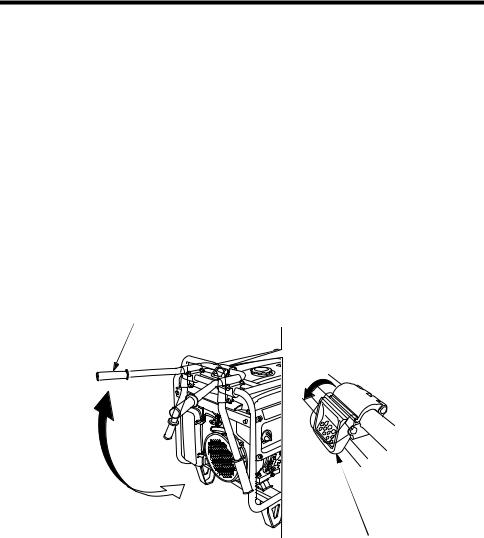
CONTROL & FEATURES
Folding Handle
The foldable handle is intended for ease of transportation and should be folded when the generator is stationary. Do not rest objects on the extended handle.
To Extend The Handle
Lift handle upward. Lock lever will lock and secure the handle into place.
To Fold The Handle
1.Press handle lock lever downward.
2.Lower the handle.
HANDLE
Handle transport position
Generator stationary position
HANDLE LOCK LEVER
18

CONTROLS & FEATURES
FEATURES
Oil Alert® System
The Oil Alert system is designed to prevent engine damage caused by an insufficient amount of oil in the crankcase. Before the oil level in the crankcase can fall below a safe limit, the Oil Alert system will automatically stop the engine (the engine switch will remain in the ON position).
If the engine stops and will not restart, check the engine oil level (see page 47) before troubleshooting in other areas.
Automatic Engine Stop Function
Oil Alert Function
During operation, the engine will automatically stop if there is not enough oil in the tank. Moreover, if the generator is on a slope, the oil alert function may operate and stop the engine.
Overspeed Detection Function
To protect the engine from exceeding the engine load, the engine will automatically stop if the engine speed becomes abnormal.
Abnormal Voltage Detection Function
The engine will automatically stop during generation when it detects abnormal voltage.
If the engine stops, make sure the oil level is correct. Wait a few minutes, and then try to restart the engine. If the engine still won’t start, take the generator to your authorized servicing Honda power equipment dealer.
19
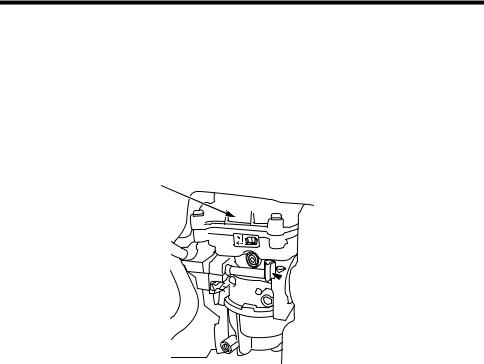
CONTROLS & FEATURES
Auto Choke and Throttle Control System
The ECM of this engine controls the choke valve and throttle automatically.
When starting and warming up the engine, you do not need to operate the choke lever unless the engine is hard to start using the normal starting procedure.
* ECM
 MANUAL CHOKE LEVER
MANUAL CHOKE LEVER
* ECM: Engine Control Module
iAVR (Intelligent Auto Voltage Regulator)
This generator is equipped with an intelligent, automatic voltage regulator. The iAVR provides power in excess of the maximum rating for up to ten seconds to start appliances that require high startup current.
The total amount of power available for each generator model is: EM4000SX 5,000 watts for up to 10 seconds
EM5000SX 7,000 watts for up to 10 seconds EM6500SX 7,000 watts for up to 10 seconds
20
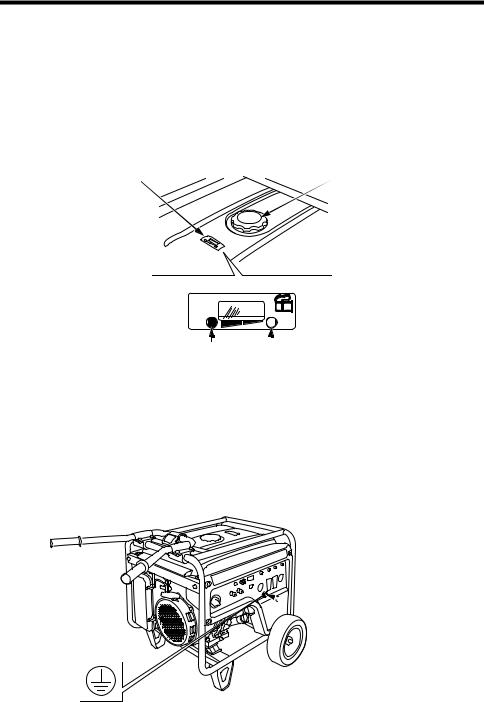
CONTROLS & FEATURES
Fuel Gauge
The fuel gauge is a mechanical device that measures the fuel level in the tank. The red indicator in the window will reference the level in relation to full or empty. To provide increased operating time, start with a full tank before beginning operation. Check the fuel level with the generator on a level surface. Always refuel with the engine OFF and cool.
FUEL GAUGE |
FUEL TANK CAP |
FULL EMPTY
Ground Terminal
The generator ground terminal is connected to the frame of the generator, the metal non-current-carrying parts of the generator, and the ground terminals of each receptacle.
Before using the ground terminal, consult a qualified electrician, electrical inspector, or local agency having jurisdiction for local codes or ordinances that apply to the intended use of the generator.
 GROUND TERMINAL
GROUND TERMINAL
21

BEFORE OPERATION
ARE YOU READY TO GET STARTED?
Your safety is your responsibility. A little time spent in preparation will significantly reduce your risk of injury.
Knowledge
Read and understand this manual. Know what the controls do and how to operate them.
Familiarize yourself with the generator and its operation before you begin using it. Know how to quickly shut off the generator in case of an emergency.
If the generator is being used to power appliances, be sure that they do not exceed the generator’s load rating (see page 33).
IS YOUR GENERATOR READY TO GO?
For your safety, to ensure compliance with environmental regulations, and to maximize the service life of your equipment, it is very important to take a few moments before you operate the generator to check its condition. Be sure to take care of any problem you find, or have your servicing dealer correct it, before you operate the generator.
Failure to properly maintain this generator, or failing to correct a problem before operation, could result in a significant malfunction.
Some malfunctions can seriously hurt or kill you.
Always perform a pre-operation inspection before each operation and correct any problems.
22

BEFORE OPERATION
To prevent a possible fire, keep the generator at least 3 feet (1 meter) away from building walls and other equipment during operation. Do not place flammable objects close to the engine.
Before beginning your pre-operation checks, be sure the generator is on a level surface and the engine switch is in the OFF position.
Check the Engine
•Before each use, look around and underneath the engine for signs of oil or gasoline leaks.
•Check the oil level (see page 47). A low oil level will cause the Oil Alert system to shut down the engine or prevent it from starting.
•Check the air cleaner (see page 50). A dirty air cleaner element will restrict air flow to the carburetor, reducing engine and generator performance.
•Check the fuel level (see page 45). Starting with a full tank will help to eliminate or reduce operating interruptions for refueling.
Check the GFCI
Check the GFCI operation (see page 29) after starting the engine.
23

OPERATION
SAFE OPERATING PRECAUTIONS
Before operating the generator for the first time, review chapters
GENERATOR SAFETY (see page 6) and BEFORE OPERATION (see page 22).
For your safety, do not operate the generator in an enclosed area such as a garage. Your generator’s exhaust contains poisonous carbon monoxide gas that can collect rapidly in an enclosed area and cause illness or death.
Exhaust contains poisonous carbon monoxide gas that can build up to dangerous levels in closed areas.
Breathing carbon monoxide can cause unconsciousness or death.
Never run the generator in a closed, or even partly closed area where people may be present.
Before connecting an AC appliance or power cord to the generator:
•Use grounded 3-prong extension cords, tools, and appliances, or double-insulated tools and appliances.
•Inspect cords and plugs, and replace if damaged.
•Do not use cord lengths greater than 164 feet (50 meters), and do not use multiple tools and appliances with built-in noise filters. Such use may activate the GFCI.
•Make sure that the appliance is in good working order. Faulty appliances or power cords can create a potential for electric shock.
•Make sure the electrical rating of the tool or appliance does not exceed the rated power of the generator or the receptacle being used.
•Operate the generator at least 3 feet (1 meter) away from buildings and other equipment.
•Do not operate the generator in an enclosed structure.
•Do not place flammable objects close to the engine or locate the generator near flammable materials.
24
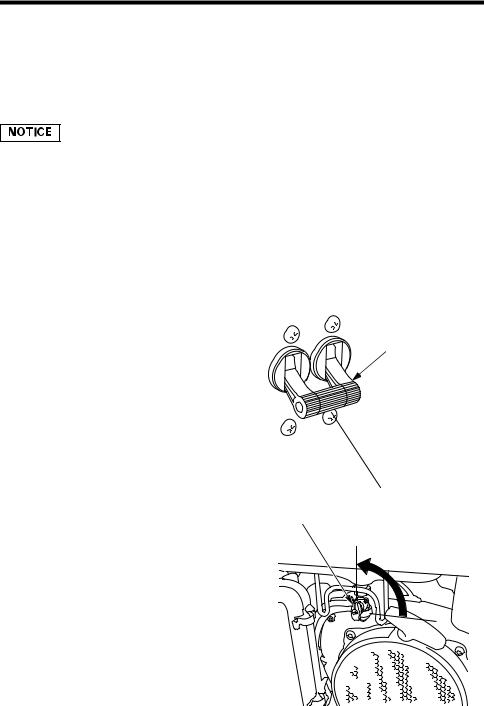
OPERATION
STARTING THE ENGINE
To prevent a possible fire, keep the generator at least 3 feet (1 meter) away from building walls and other equipment during operation. Do not place flammable objects close to the engine.
Operating this generator less than 3 feet (1 meter) from a building or other obstruction can cause overheating and damage the generator. For proper cooling, allow at least 3 feet (1 meter) of empty space above and around the generator.
Refer to SAFE OPERATING PRECAUTIONS on page 24 and perform the IS YOUR GENERATOR READY TO GO checks (see page 22). Refer to AC OPERATION (see page 31) or DC OPERATION (see page 37) for connecting loads to the generator.
1.Make sure that all appliances are disconnected from the AC receptacle.
2.Make sure that the AC circuit breaker is in the OFF position.
3.Turn the fuel valve lever to the ON position.
AC CIRCUIT BREAKER
OFF
FUEL VALVE LEVER
ON
25
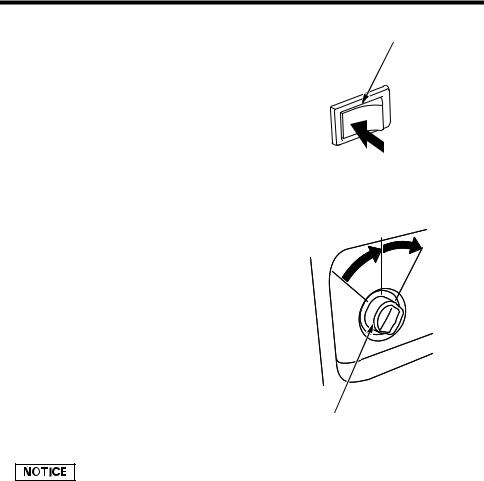
OPERATION
4.Make sure the Auto Throttle switch is in the OFF position, or more time will be required for warm up.
AUTO THROTTLE SWITCH
OFF
5. Start the engine.
• Using the electric starter:
Turn the engine switch to the START position, and hold it there until the engine starts. When the engine starts, release the key, allowing the switch to return to the ON position.
If the engine fails to start within 5 seconds, release the key, and wait at least 10 seconds before operating the starter again.
ON
START
OFF
ENGINE SWITCH
Using the electric starter for more than 5 seconds at a time will overheat the starter motor and can damage it.
Do not leave the engine switch in the ON position when the generator is not operating as the battery will discharge. Turn the engine switch to the OFF position when not in use.
26
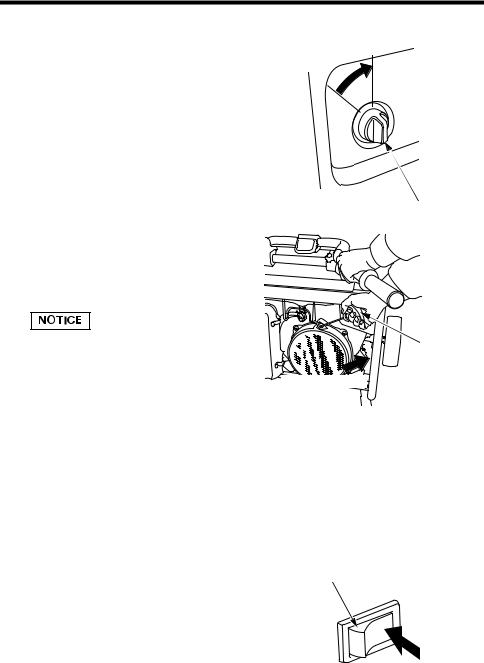
OPERATION
•Using the recoil starter:
a.Turn the engine switch to the ON position.
b.Pull the starter grip lightly until you feel resistance; then pull briskly in the direction of the arrow as shown.
•Do not allow the starter grip to snap back against the engine. Return it gently to prevent damage to the starter.
•Do not let the starter rope rub against the generator body, or the rope will wear out prematurely.
•Be careful not to hit your hand against the handle when pulling the starter grip.
6.If you wish to use the Auto Throttle system, turn the Auto Throttle switch to the ON position after the engine has warmed up for 2 or 3 minutes.
ON
ENGINE SWITCH
STARTER
GRIP
Direction to pull
AUTO THROTTLE SWITCH
ON
27
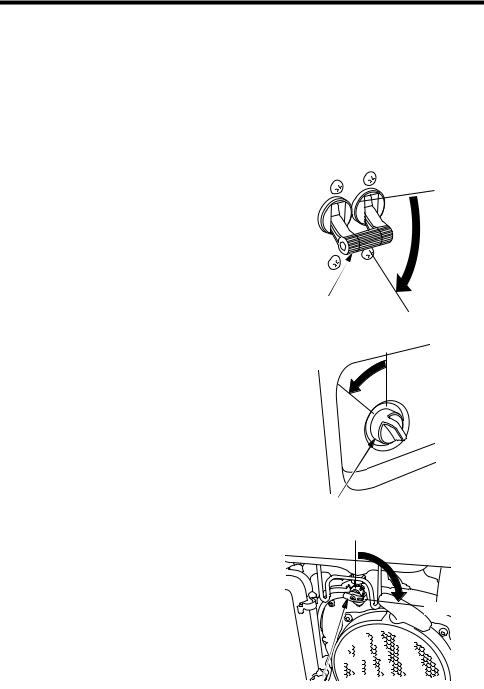
OPERATION
STOPPING THE ENGINE
To stop the engine in an emergency, simply turn the engine switch to the OFF position. Under normal conditions, use the following procedure.
1.Turn off or disconnect all appliances that are connected to the generator.
2. Move the AC circuit breaker to the OFF position.
3.Turn the engine switch to the OFF position.
AC CIRCUIT BREAKER
OFF
OFF
ENGINE SWITCH
4.Turn the fuel valve lever to the OFF position.
OFF
FUEL VALVE LEVER
28
